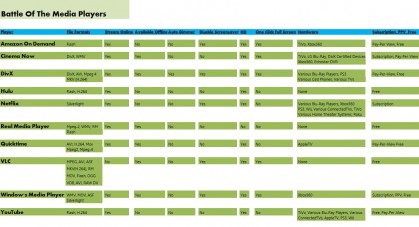While old school media types insist that content is king, when it comes to viewing said content, format and media player can make a big difference in the quality of the user experience. With new options seeming to crop up every day, let’s take a look at a few of the most popular software media players (and video destinations) to determine which one may be best for consumers. Individual results may vary, but here are the criteria I used to evaluate each:
Format Support
With so many different formats out there, it’s important that your top media player has robust support. Since consumers shouldn’t have to scour the web to add additional functionality, I didn’t include any plugins that consumers could use to expand support. Of all the players listed, the VLC clearly won this category. Whether you’re trying to watch Quicktime movies or play a VOB file, if VLC can’t handle the codec, you probably shouldn’t be trying to play it to begin with. The clear loser in this category was the Netflix Media player. While I have no complaints about the quality of their stream, the DRM restrictions and the requirement for downloading the Silverlight plugin, makes their web player pretty limited.
Ability to Stream Online
When digital movies first arrived, you’d have to wait a couple hours for the video to download. With the introduction of streaming media, consumers rarely have to wait more than a few seconds in order to access to that content. While most video players are able to support this functionality, I feel that Netflix is the clear winner for this category. Not only do their video streams take into account your bandwidth to reduce buffering issues, but they also seem to have the highest video quality when streaming content. The clear loser in this category was the VLC player. While technically, there are ways to use it to stream torrent files while downloading, for the most part the VLC player is best suited for offline media.
